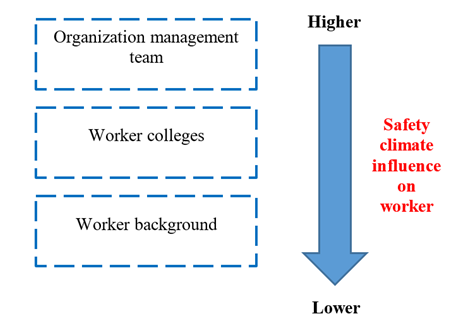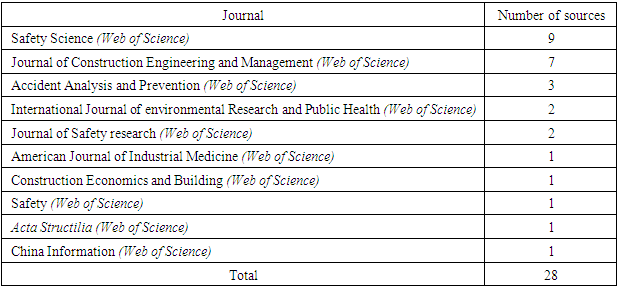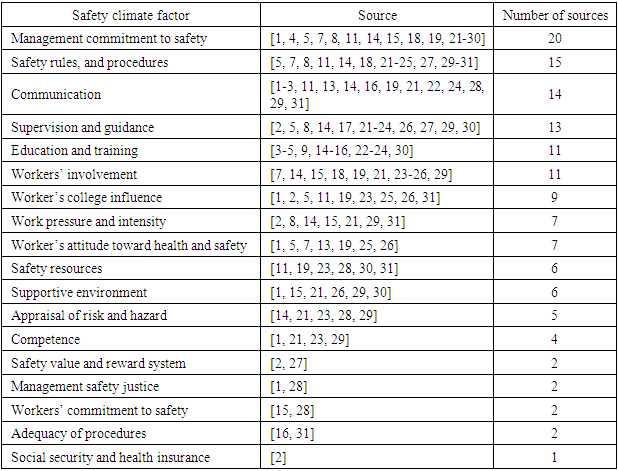-
Paper Information
- Paper Submission
-
Journal Information
- About This Journal
- Editorial Board
- Current Issue
- Archive
- Author Guidelines
- Contact Us
International Journal of Construction Engineering and Management
p-ISSN: 2326-1080 e-ISSN: 2326-1102
2019; 8(3): 105-109
doi:10.5923/j.ijcem.20190803.03

Factors Influencing Safety Climate in the Construction Industry: A Review
Ibrahim Mosly
Civil Engineering Department, College of Engineering – Rabigh Branch, King Abdulaziz University, Jeddah, Saudi Arabia
Correspondence to: Ibrahim Mosly, Civil Engineering Department, College of Engineering – Rabigh Branch, King Abdulaziz University, Jeddah, Saudi Arabia.
| Email: |  |
Copyright © 2019 The Author(s). Published by Scientific & Academic Publishing.
This work is licensed under the Creative Commons Attribution International License (CC BY).
http://creativecommons.org/licenses/by/4.0/

The construction industry represents a significant share of the economy for any country. Nevertheless, it is considered a dangerous industry, where the level of injuries and deaths is generally high compared to other industries. As a result, it becomes important to maintain adequate levels of safety performance on construction sites, and this can be promoted by raising the safety climate amongst the construction industry personnel. This research study aimed to identifying the factors influencing the safety climate in the construction industry. A literature review was the main method of data collection, and only journals included on the Web of Science platform were considered in the process of identifying key factors. As a result, 18 factors were identified and grouped into management related safety climate factors, and worker-related safety climate factors. In conclusion, it was found that the organization’s management team had the greatest influence on safety climate; thus, they are considered accountable for safety measures as a result.
Keywords: Construction industry, Safety climate, Factors
Cite this paper: Ibrahim Mosly, Factors Influencing Safety Climate in the Construction Industry: A Review, International Journal of Construction Engineering and Management , Vol. 8 No. 3, 2019, pp. 105-109. doi: 10.5923/j.ijcem.20190803.03.
Article Outline
1. Introduction
- The construction industry plays a vital part in the economy of nations worldwide. In most countries, it is considered one of the key economic pillars [1]. As the construction industry booms with a constant rise in production, the rate of accidents and deaths have also continued to increase [2]. Thus, the relationship between construction projects and safety risks and hazards demonstrates a positive correlational relationship, as it is considered to be amongst the most dangerous industries worldwide [2,3]. Hence, practices that prevent the industry-related dangers are mainly promoted by law, by people, by the related economic cost of accidents, and by administrative surveillance [3]. The presence of safety practices, procedures, and guidelines becomes an essential element for the survival and wellbeing of construction industry personnel. Furthermore, the development of health and safety principles from an organizational perspective is a significant subject of international concern [4]. Thus, both regulating authorities and organizations should prioritize the perception of safety and verify its thorough implementation on construction sites. At construction sites, employees’ play a significant role when it comes to their own and others’ safety. Their safety awareness can be increased and their unsafe actions can be reduced by a positive safety climate [5]. Safety climate is linked to workers’ perceptions of safety rules, procedures, and practices as conveyed by the management, co-workers, and supervisors in an organization [6]. Thus, all construction organization stakeholders must have a unified safety goal. A lot of attention has been focused on safety climate, as it reveals the factual significance of safety in an organization [7]. Safety climate is a practical diagnostic tool, as it can facilitate the recognition problems that might be seen vital to improving safety [3]. Measuring the safety climate on worksites should be encouraged by employers, to recognize and resolve organizational and management problems of safety before the occurrence of safety accidents [8]. Accordingly, safety climate is linked to safety performance. In fact, safety climate can predict the levels of safety performance [9,10], and safety climate and safety performance share a positive relationship [11]. An organizations’ safety performance can be improved by encouraging a progressive safety climate and evolving training programs to enhance staff psychological health [9]. Securing reliable crucial factors that cover the safety climate is vital in enabling the evaluation of safety climate, which supports the recognition of effective methods to enhance safety performance [5]. Eventually, high safety climate levels in a company could result in employees perceiving that maintaining good safety practices is encouraged, in spite of increased production pressure; thus, they will behave safely [12].
2. Safety Climate Research in the Construction Industry Worldwide
- To recognize the influencing safety climate factors in the construction industry, it is important to review research carried out in different countries worldwide. In general, research on safety climate and psychological strains on safety performance are limited [13]. In fact, a research gap exists in the literature of safety climate dimensions, from 2014 to present [14]. Nevertheless, a number of research studies on safety climate were reviewed, and the majority did address the important factors that influence safety climate. For instance, in a research study that examined safety in the Chinese construction industry, it was shown that the most effective stimulator of safety climate factors was constituting safety regulations and rules, together with the provision of more safety training and promotions [5]. In another study carried out in New Zealand, research investigated the methods by which main safety climate factors and individual factors affect construction workers safety behaviour [15]. Results revealed that there is a major relationship between the safety commitment of management, social support, and production pressure [15]. As a significant factor, production pressure has a direct and major effect on all safety aspects [15], as was the influence of social support on safety behaviour (although the effect on safety participation was excluded as it was found to be insignificant) [15]. Furthermore, factors including safety knowledge and safety motivation were found to have a direct effect on safety participation [15]. A research study from Ontario, Canada, exploring a specific part of safety climate illustrated that safety climate affects construction labourers safety performance as well as their psychological stress [9]. Further, in South Africa, a research study investigated the features of safety climate that exist among construction personnel and its influence on safety performance [16]. It concluded that relationships are the most important factor contributing mainly to safety performance through adequate procedures, training, and constructive communication [16]. Furthermore, a research study that examined the variances in safety climate perceptions between job positions in North America revealed that differences exist according to job position [17]. Results showed that the highest safety climate score came from project managers, followed by supervisors, then technical support employees and supervisors, and finally labourers [17]. Moreover, a research study undertaken in Hong Kong suggested that safety climate could be implemented as a significant investigative tool for assessing and enhancing site safety for construction sites [18]. It concluded that measuring safety climate could evaluate the way safety is functions on a construction site, and may therefore warn management of potential safety system failures [18]. Another study conducted in Hong Kong targeted the perception of ethnic minorities in the construction industry, and identified three safety climate factors, as follows: 1) safety resources, management commitment, and communication; 2) employee's participation and worker college influence; and 3) view of safety rules, procedures, and risks [11]. The study also demonstrated that workers’ perceptions of safety climate varied greatly, depending on citizenship, marital status, dependents, and alcohol consumption [11]. Furthermore, the succeeding part of the study showed that safety climate is clearly linked to safety behaviours, which includes safety involvement and safety compliance [19]. Furthermore, it was found that safety behaviours were adversely linked to “close calls” and injuries for ethnic minority construction labourers [19]. Consequently, safety compliance and safety involvement of ethnic minority construction labourers can be enhanced by a more positive safety climate [19]. A research study carried out on the Colombian construction industry demonstrated better safety climate scores for managers compared to supervisors and labourers [20]. From the previous safety climate studies results it can be seen that safety climate can vary from one country to another, due to a wide range of issues. Furthermore, it is essential to perform research to identify the influencing factors for safety performance, and to examine the effects of safety climate on construction project safety [18]. Therefore, this research will aim to examine the factors influencing safety climate in the construction industry and to identify them in a holistic matter.
3. Research Methodology
- Literature review forms the basis of this research and is the main source of data. The search for literature was carried out through the Saudi digital library (SDL), which provided access to many of the reputational academic databases. The main keywords used during the search included 1) Factors, 2) Safety climate, and 3) Construction. All journal articles that included clear representation of safety climate factors and was included in the Web of Science platform where considered in the safety climate factors identification process. The main objective of the literature review process was to examine previous research conducted in relation to this topic, as well as to identify the safety climate factors recognized by other researchers from different countries. The question investigated in this research was, “What are the influencing safety climate factors in the construction industry?” The answer to this research question provided the main contribution to knowledge in the form of a comprehensive list of safety climate factors in the construction industry collected from various high-quality research studies.
4. Results and Discussion
- In total, 28 articles from 10 journals were referenced for the identification of the factors influencing safety climate in the construction industry (see Table 1). As previously mentioned in the research methodology section, only journal articles that were included on the Web of Science platform where considered for this process. This was made to ensure the production of a sound and inclusive list of factors influencing safety climate in the construction industry. Due to the relevance of the topic of two journals (Safety Science, and Journal of Construction Engineering and Management), these contained the greatest number of articles referenced in the factors identification process.
|
|
 | Figure 1. Safety climate influencing levels |
5. Conclusion and Future Work
- This study resulted in the identification of 18 factors that influences safety climate in the construction industry. In order to have a safe construction site with high safety performance levels, safety climate must be the utmost priority of any organization’s management team. They represent the top of the pyramid of power and their decisions affect employees and work output. Furthermore, attention should be given to the influence of workers on their colleges in terms of positive or negative safety perceptions. Finally, construction workers must be encouraged to develop themselves to adopt safety climate good practice in their daily job activities and to promote good safety practices. It will be interesting to conduct future research to explore, rank, and group the identified factors influencing safety climate in the construction industry, by using a questionnaire survey distributed among field professionals and workers. In addition, studying comparisons between different groups of industry professionals and their perspective on the identified factors influencing safety climate in the construction industry could yield interesting results. This will assist in providing a more holistic view on safety climate in the construction industry and add to the existing research available.
 Abstract
Abstract Reference
Reference Full-Text PDF
Full-Text PDF Full-text HTML
Full-text HTML
